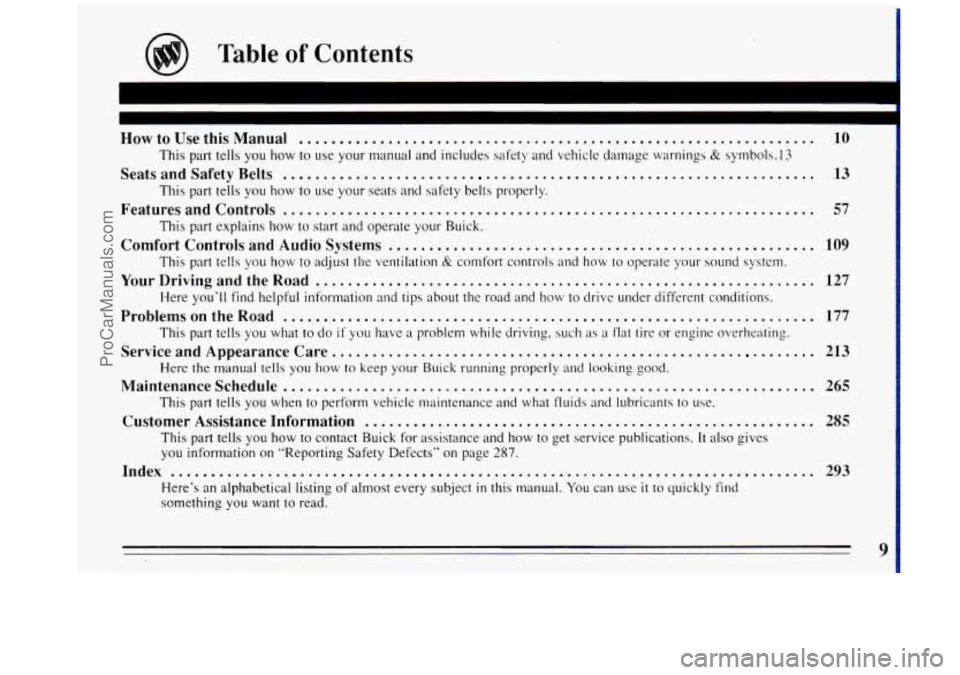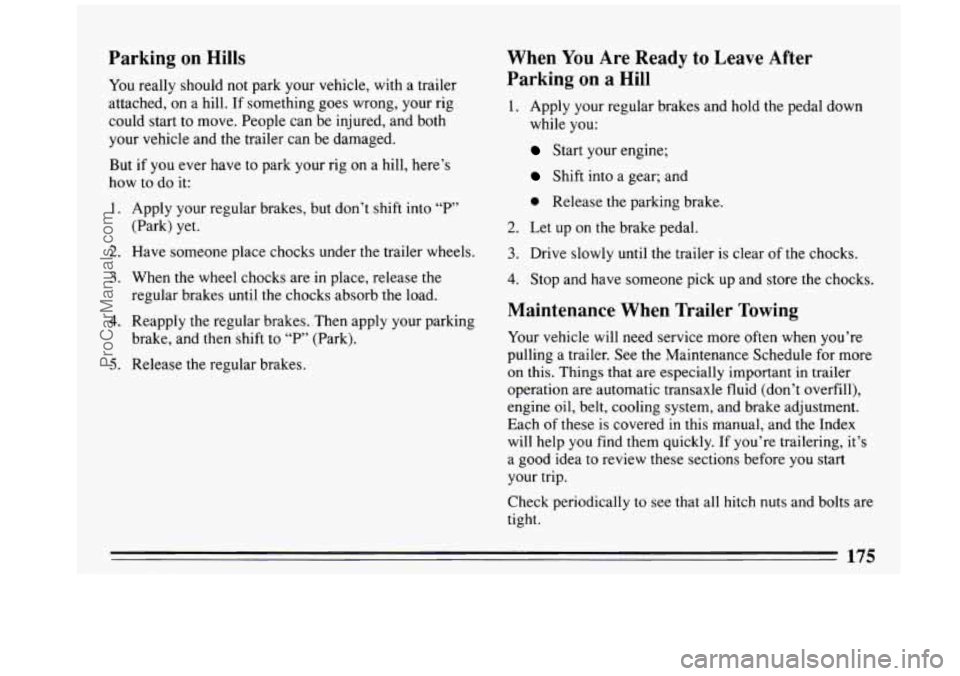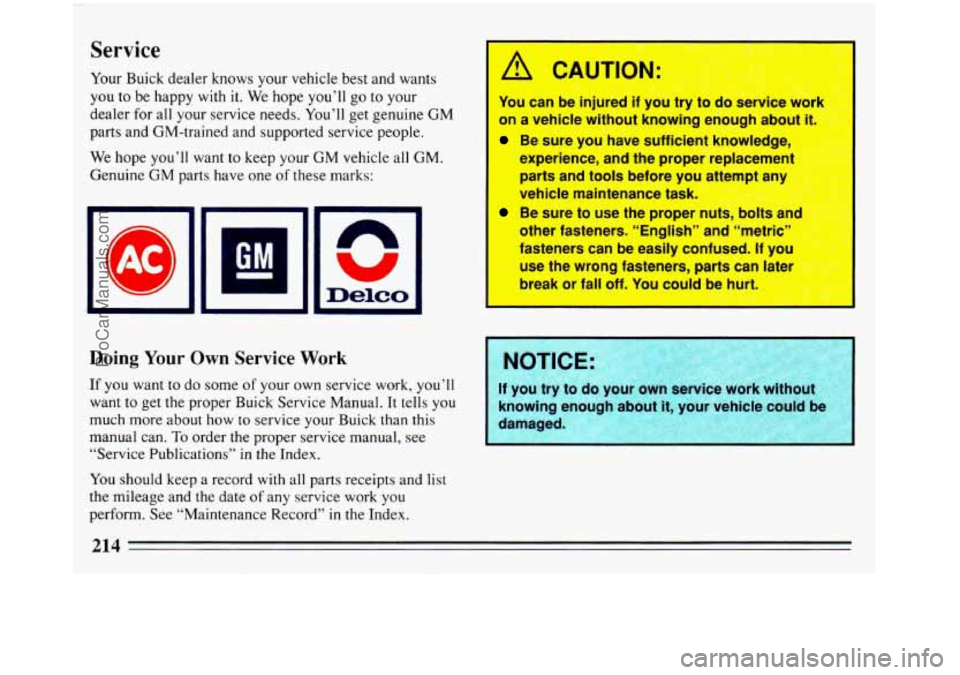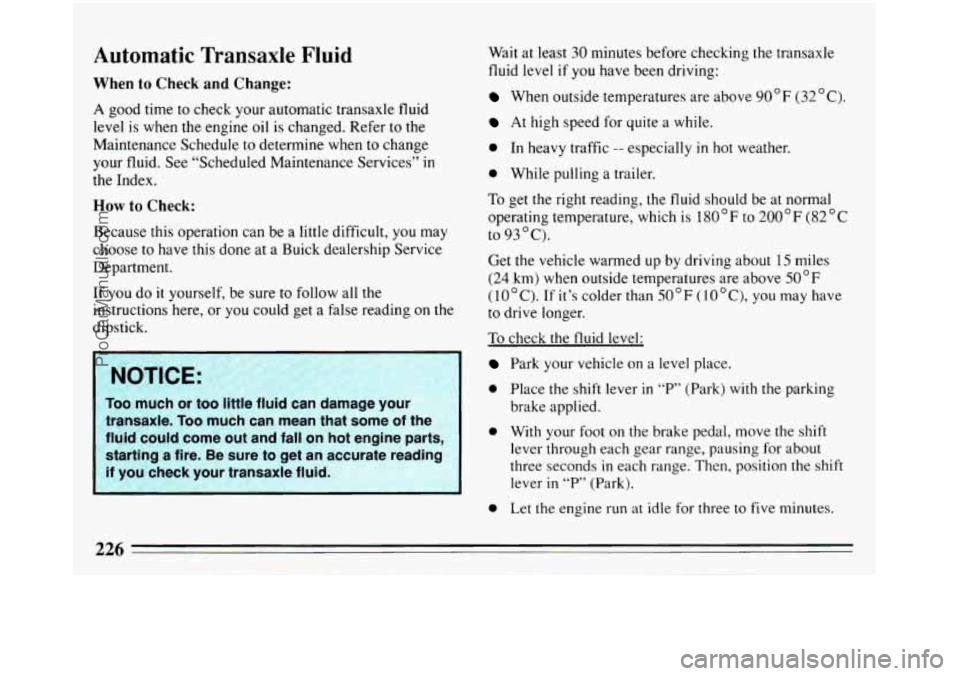Page 11 of 308

HowtoUsethisManual ................................................................ 10
Seats and Safety Belts
. . . . . . . . . . . . . . . . . . . . . . . . . . . . . . . . . . . . . . . . . . . . . . . . . . *. . . . . *. . . . . . . . 13
FeaturesandControls
.................................... ............................... 57
Comfort Controls and Audio Systems . . . . . . . . . . . . . . . . . . . . . . . . . . . . . . . . . . . . . . . . . . . . . . . . I.. . I 109
YourDrivingandtheRoad
.............0.0..........s...................................... 127
ProblemsontheRoad
.................................................................. 177
Service and Appearance Care..
. . . . . . . . . . . . e . . . . . . . . . . . . . . . . . . . . . . . . . . . . . . . . . . . . . . . . . . 213
Maintenanceschedule
.................................................................. 265
Customer Assistance Information
. . . . . . . . . . . . . . . . . . . . . . . . . . . . . . . . . . . . . . . . . . . . . . . . . . . . . . . . 285
This part tells you how to use your manual and includes safety and vehicle damage warnings & symbols. 13
This part tells you how to use your seats and safety belts properly.
This part explains how
to start and operate your Buick.
This part tells you how to adjust the ventilation
& comfort controls and how to operate your sound system.
Here you’ll find helpful information and tips about the road and how
to drive under different conditions.
This part tells you what
to do if’ you have a problem while driving, such as a flat tire or engine overheatins.
Here the manual tells you how to keep your Buick running properly and looking good.
This part tells you when
to perf’orm vehicle maintenance and what fluids and lubricants to use.
This part tells you how to contact Buick for assistance and how
to get service publications. It also gives
you information on “Reporting Safety Defects” on page
287.
Here’s an alphabetical listing of almost every subject in this manual. You can use it to quickly find
something you want to read.
Index ........................................................................\
........ 293
9
ProCarManuals.com
Page 131 of 308
I ,- A-
i?
u
RAILROAD ADVANCE
CROSSING NARROW
BRIDGE LOW
SHOULDER
Y
FLAGGER
AHEAD
/
WORKERS AHEAD
YELLOW indicates a general warning. Slow down and ORANGE indicates road construction or maintenance.
be careful when you see a yellow sign. It may signal a You’ll want to
slow down when you see an orange sign,
railroad crossing ahead,
a no passing zone, or some as part of the road may be closed off or torn up. And
other potentially dangerous situation. Likewise, a yellow there
may be workers and maintenance vehicles around,
solid line painted on
the road means “Don’t Cross.” too.
ProCarManuals.com
Page 177 of 308

Parking on Hills
You really should not park your vehicle, with a trailer
attached, on a hill. If something goes wrong, your rig
could start to move. People can be injured, and both
your vehicle and the trailer can be damaged.
But if
you ever have to park your rig on a hill, here’s
how to do it:
1.
2.
3.
4.
5.
Apply your regular brakes, but don’t shift into “P’
(Park) yet.
Have someone place chocks under the trailer wheels.
When the wheel chocks are in place, release the
regular brakes until the chocks absorb the load.
Reapply the regular brakes. Then apply your parking
brake, and then shift to “P” (Park).
Release the regular brakes.
When You Are Ready to Leave After
Parking on
a Hill
1. Apply your regular brakes and hold the pedal down
while you:
Start your engine;
Shift into a gear; and
0 Release the parking brake.
2. Let up on the brake pedal.
3. Drive slowly until the trailer is clear of the chocks.
4. Stop and have someone pick up and store the chocks.
Maintenance When Trailer Towing
Your vehicle will need service more often when you’re
pulling a trailer. See the Maintenance Schedule for more
on this. Things that are especially important in trailer
operation are automatic transaxle fluid (don’t overfill),
engine oil, belt, cooling system, and brake adjustment.
Each
of these is covered in this manual, and the Index
will help you find them quickly. If you’re trailering, it’s
a good idea to review these sections before
you start
your trip.
Check periodically to see that all hitch nuts and bolts are
tight.
175
ProCarManuals.com
Page 216 of 308

Service
Your Buick dealer knows your vehicle best and wants
you to be happy with
it. We hope you’ll go to your
dealer for all your service needs. You’ll get genuine
GM
parts and GM-trained and supported service people.
We hope you’ll want to keep your GM vehicle all
GM.
Genuine GM parts have one of these marks:
Doing Your Own Service Work
If you want to do some of your own service work, you’ll
want to get the proper Buick Service Manual. It tells you
much.more about how to service your Buick than this
manual can.
To order the proper service manual, see
“Service Publications” in the Index.
I A CAUTlvN:
You can be injured if you try to do service work
on a vehicle without knowing enough about it
Be sure you have sufficient knowledge,
experience, and the proper replacement
parts and tools before you attempt any
vehicle maintenance task.
Be sure to use the proper nuts, bolts ancI
other fasteners. “English” and “metric”
fasteners
can be easily confused. If you
use the wrong fasteners, parts can later
break or fall off. You could be hurt.
You should keep a record with all parts receipts and list
the mileage and
the date of any service work you
perform. See “Maintenance Record” in the Index.
214
ProCarManuals.com
Page 227 of 308
properly disposing of your used oil, ask your dealer, a
service station or a local recycling center for help.
Air Cleaner
The air cleaner is in the right front area of the engine
compartment.
I A CAUTION:
Operating the engine with the air cleaner off can
cause you or others to be burned. The air cleaner
not only cleans the air,
it stops flame if the
engine backfires. If it isn’t there, and
the engine
backfires, you could be burned. Don’t drive with
it
off, and be careful working on the engine with
the air cleaner off.
I
Refer to the Maintenance Schedule to determine when
to replace the air filter.
See “Scheduled Maintenance Services’’ in the Index.
225
ProCarManuals.com
Page 228 of 308

Automatic Transaxle Fluid
When to Check and Change:
A good time to check your automatic transaxle fluid
level is when
the engine oil is changed. Refer to the
Maintenance Schedule to determine when to change
your fluid. See “Scheduled Maintenance Services” in
the Index.
How to Check:
Because this operation can be a little difficult, you may
choose to have this done at a Buick dealership Service
Department.
If you do it yourself, be sure to follow all the
instructions here, or you could get a false reading on the
dipstick.
NOTICE:
Too much or too little fluid can damage your
transaxle.
Too much can mean that some of the
fluid could come out and fall
on hot engine parts,
starting a fire. Be sure to get an accurate reading
if you check your transaxle fluid.
Wait at least 30 minutes before checking the transaxle
fluid level if you have been driving:
When outside temperatures are above 90°F (32 ” C).
At high speed for quite a while.
0 In heavy traffic -- especially in hot weather.
0 While pulling a trailer.
To get the right reading, the fluid should be at normal
operating temperature, which is
180 F to 200 F (82 C
Get the vehicle warmed up by driving about 15 miles
(24 km) when outside temperatures are above
50°F
(10°C). If it’s colder than 50°F (lO°C), you may have
to drive longer.
To check the fluid level:
Park your vehicle on a level place.
0 Place the shift lever in “F’ (Park) with the parking
0 With your foot on the brake pedal, move the shift
to
93
O C).
brake applied.
lever through each gear range, pausing for about
three seconds
in each range. Then, position the shift
lever
in “P” (Park).
0 Let the engine run at idle for three to five minutes.
226
ProCarManuals.com
Page 229 of 308
Then, without shutting off the engine, follow these
steps:
1. Pull out the dipstick
and wipe it with
a
clean rag or paper
towel.
‘i
2. Push it back in all the way, wait three seconds and
then pull it back out again.
A
3. Check both sides of the dipstick, and read the lower
level. The fluid level must be
in the cross-hatched
area.
4. If the fluid level is where it should be, push the
dipstick back
in all the way.
How to Add Fluid:
Refer to the Maintenance Schedule to determine what
kind
of transaxle fluid to use. See “Recommended
Fluids and Lubricants’’
in the Index.
ProCarManuals.com
Page 234 of 308
What to Add:
Refer to the Maintenance Schedule to determine what
kind of fluid to use. See “Recommended
Fluids and
Lubricants” in the Index.
Windshield Washer Fluid
To Add:
I -1
I NOTICE: I
When adding power steering fluid or making a
complete fluid change, always use the proper
fluid. Failure to use the proper fluid can cause
leaks and damage hoses and seals.
1
A
4 LA ..
11
Open the cap labeled “WASHER FLUID ONLY.” Add
washer fluid until
the bottle is full.
ProCarManuals.com